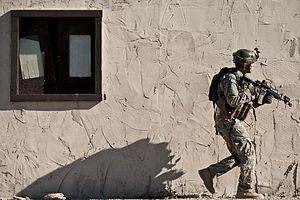5th Air Support Operations Squadron
The United States Air Force's 5th Air Support Operations Squadron is a combat support unit located at Fort Lewis, Washington. The squadron provides tactical command and control of airpower assets to the Joint Forces Air Component Commander and Joint Forces Land Component Commander for combat operations.
5th Air Support Operations Squadron
 | |
|---|---|
 A squadron joint tactical air controller provides security during a training exercise at Fort Irwin. | |
| Active | 1942–1945; 1994–present |
| Country | |
| Branch | |
| Role | Air Support Operations |
| Size | Squadron |
| Part of | Air Combat Command |
| Garrison/HQ | Fort Lewis |
| Engagements | Southwest Pacific Theater Iraq War[1] |
| Decorations | Air Force Outstanding Unit Award with Combat "V" Device Air Force Outstanding Unit Award Philippine Presidential Unit Citation[1] |
| Insignia | |
| 5th Air Support Operations Squadron emblem (approved 28 October 1996)[1] | |
History
World War II
The squadron was first activated in May 1942 as the 5th Communications Squadron. After training in the United States, it moved to Australia in May 1943, where it became an element of Fifth Air Force as the 5th Air Support Communication Squadron. It participated in combat, earning arrowhead devices for participation in amphibious landings in New Guinea, the Bismark Archipelago, and Leyte. Its air support parties served with United States Marines and United States and Australian Army forces, directing air support missions for the forces they served. After V-J Day, the squadron was inactivated in the Philippines in November 1945.[1]
Reactivation
The squadron was reactivated at Fort Lewis, Washington in July 1994 as the 5th Air Support Operations Squadron. It has supported combat operations during the Global War on Terror since 2001.[1] The unit's Joint Terminal Attack Controllers are traditionally aligned with I Corps and the Joint Base Lewis-McChord based Stryker Brigades, but due to manning shortages and theater requirements, the unit's airmen have deployed with many different units during the past decade.[2]
Lineage
- Constituted as the 5th Communications Squadron, Air Support on 15 May 1942
- Activated on 22 May 1942
- Redesignated 5th Air Support Communication Squadron on 11 January 1943
- Redesignated 5th Air Support Control Squadron on 20 August 1943
- Redesignated 5th Tactical Air Communications Squadron on 1 April 1944
- Inactivated on 28 November 1945
- Disbanded on 8 October 1948
- Reconstituted and redesignated 5th Air Support Operations Squadron on 24 June 1994
- Activated on 1 July 1994[1]
Assignments
- I Ground Air Support Command (later I Air Support Command), 15 May 1942
- Fifth Air Force, June 1943
- 308th Bombardment Wing, 25 July 1945
- XIII Bomber Command, 20 October–28 November 1945
- 1st Air Support Operations Group, 1 July 1994 – present[1]
Stations
- Mitchel Field, New York, 22 May 1942
- Lebanon, Tennessee, 9 September 1942
- Morris Field, North Carolina, c. 21 October 1942 – 8 May 1943
- Brisbane, New South Wales, Australia, 13 June 1943
- Cairns, Queensland, Australia, 26 July 1943
- Port Moresby, New Guinea, 11 September 1943
- Finschhafen, New Guinea, 29 February 1944
- Hollandia, New Guinea, Netherlands East Indies, 30 August 1944
- Morotai, Netherlands East Indies, 1 October 1944
- Clark Field, Luzon, Philippines, 14 May–28 November 1945
- Fort Lewis (later Joint Base Lewis-McChord), Washington, 1 July 1994 – present[1]
References
Notes
- Dollman, TSG David (May 15, 2017). "Factsheet 5 Air Support Operations Squadron (ACC)". Air Force Historical Research Agency. Retrieved August 9, 2018.
- Smith, Lorin (June 16, 2011). "Support squadron highly skilled radiomen". I Corps Public Affairs. Retrieved August 9, 2018.
Bibliography
![]()

.jpg)
.svg.png)
.jpg)